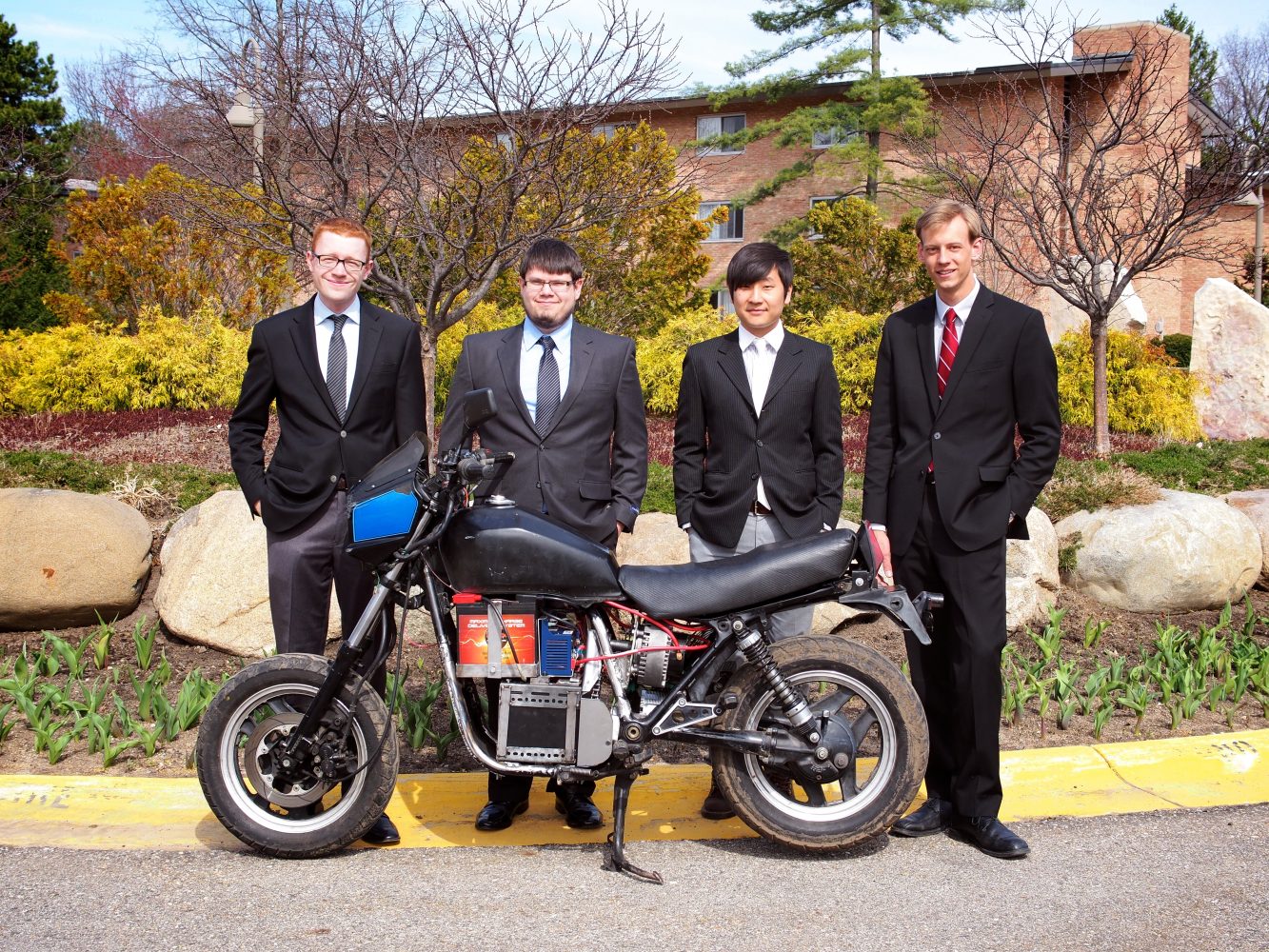The Engineering building teems with students this time of year, all putting the final touches on their senior design projects. If mental computation were audible, one would hear a din of whirrs and clicks cutting above the hum of drills and percussion of hammers. Gadgetry and papers full of scribbled calculations lie on lab benches arranged to form team enclaves. One team’s bench features an array of Mountain Dew cans that would fetch a small mint at a nearby bottle return, betraying what is, perhaps, a serious caffeine dependency. It should be noted that the same team’s workspace also features a couch and a Nintendo 64 hooked up to an old CRT television.
On the mezzanine, a young man wearing a suit drapes a schematic diagram over a too-small table. Flashes of light emanate from a 3D printer that could stand in for a boxier droid from the Star Wars universe. Sparks shower as a student takes an angle grinder to the metal frame of a machine intended to help Cambodian farmers plant legumes.
It is in this setting that Team SolarCycle is hard at work, tinkering on their solar-panel-augmented motorcycle. The bike, with its wing-like panels, looks more like it should be orbiting the planet than cruising Lake Drive.
The solar panels are, at this point, just “a proof of concept,” according to Jack Amick. Charging the bike would require more panels to fold out, which would, according to the team’s calculations, allow the bike to charge half its battery in eight hours. “Maybe if it’s not in Michigan,” smirks Mike Houtman. The panels fold down for riding and the bike must be in park to charge. “We want people to be safer, or something,” says Amick.
Nearby, a biodiesel reactor takes shape. “A week ago we had nothing,” says team member Adam Alexander, “and now it’s coming together.” Alexander points to a prominent feature of their design: a microwave oven. According to the team’s research, microwaves can make efficient and inexpensive biodiesel reactors. Their team is improving on a 2008 senior design project that aimed to reuse cooking oil from Johnny’s.
Asked if he has been sleeping, Alexander responds, “No, not really — not a whole lot.”
“We are in the serious troubleshooting phase,” says Jake Roorda. He pores over lines of code which command a robotic spotlight. The light will follow an actor wearing an infrared beacon around a stage. The beacon’s light, just barely in the range visible to the human eye, can be clearly identified by a camera. Roorda starts the device, which begins rotating. Unfortunately, it fails to stop rotating. “This is why we have the button,” remarks Roorda as he jams a prominent red button on the spotlight. “I think it will be ready,” claims Roorda, “but it will be close.”
Team SolarCycle displays cool confidence, surprising in light of the fact that as I speak with them Monday, their bike currently does not have a motor. The team believes that dirt stopped the old motor from working. “It started grinding,” says Amick, “so we took it apart to clean it and now it doesn’t work.” An order has been placed and a new motor is on the way. The team expects their motor Wednesday, just in time to ready the bike for presentations Saturday. The new motor brings some advantages. While the old motor could get up to about 40 miles per hour, the new motor should be able to reach 60.
The team’s webpage frames the idea behind the project with concerns about fossil fuel supply and the impact of carbon dioxide emissions. “We all wanted to do something that moved and something solar,” says Houtman.
“None of us had ever driven a motorcycle,” adds Amick, “so it was fun to learn about something new.”
“Money was an issue,” says Amick. While the team got their bike, a 1984 Honda Nighthawk, for a good price and sold the old motor, setbacks like the broken electric motor put them over their original budget. All told, the team spent $950 building the bike, just $100 over budget.
While electric vehicles, such as the Tesla Model S, often use lithium-ion batteries, the team opted for a cheaper Absorbed Glass Mat (AGM) battery sold for residential solar energy storage. Cost was not the only factor in the decision. “If you short one of these batteries there’s just a small flame,” says Amick. “If you short a lithium-ion battery, it explodes.” Another safety feature of an AGM battery is its interior design. “If you cut one open, it’s like a sponge inside,” said Amick, contrasting an AGM battery with a traditional car battery, which “will ooze acid if you cut it open.”
The battery happens to weigh nearly the same as the old engine — about 180 pounds — keeping the total weight of the bike near normal. “You want to cut down on weight,” observes Houtman, “to get as much mileage as possible out of it.” The broken motor foiled plans to test the vehicle’s range. “We actually have no idea how far it can go,” says Amick. The team estimates that the bike will be able to go 25 to 30 miles.
The team is undecided about what do with the bike when it is done. The bike may be donated to Calvin. “It’s fair,” says Amick, “it’s all their money.” The team does, however, plan to ride it. “It’s got everything to be street legal if you want to register it.”









